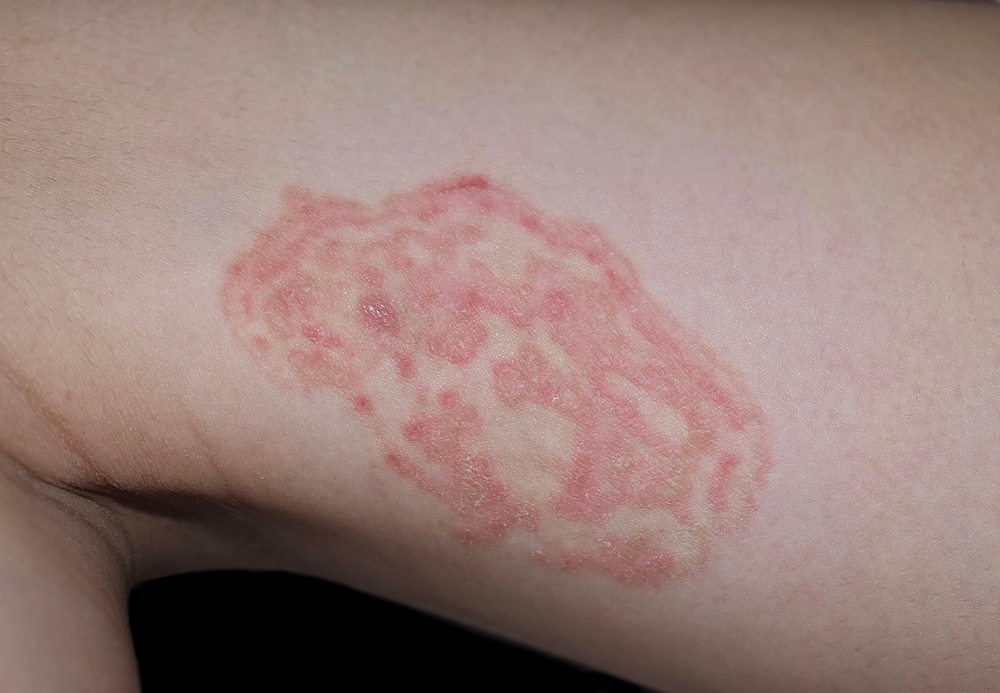Ringworm of the body, also known as tinea corporis , is a fungal skin infection characterized by ring-shaped or circular rashes. These rashes can occur on various areas of the body, except the scalp, groin, palms of the hands, and soles of the feet. Although it is a common and highly contagious condition, it is usually not serious.
Ringworm of the body is part of a group of fungal infections that affect the skin and have specific names depending on the affected area, such as:
- Tinea pedis : commonly known as athlete’s foot.
- Tinea cruris : also called jock itch, which affects the groin.
- Tinea capitis : affects the scalp and is usually more common in children.
Causes: What Causes Ringworm of the Body?
Ringworm of the body is caused by a group of fungi known as dermatophytes , which feed on keratin, a protein found in skin, hair, and nails. These fungi thrive in warm, moist environments, making it easier for them to spread in conditions such as:
- Direct contact with an infected person.
- Indirect contact through contaminated objects such as towels, clothing, or surfaces in showers and locker rooms.
- Infected pets , especially cats and dogs, can transmit the fungus to humans.
- Warm, humid environments that favor fungal growth, such as gyms, swimming pools, and saunas.

Risk Factors
Anyone can get ringworm, but some factors increase your risk of infection, including:
- Living in hot and humid climates.
- Wear tight-fitting clothing that retains moisture.
- Having frequent contact with animals.
- Sharing personal items such as combs, towels, or clothing.
- Suffering from diseases that weaken the immune system, such as diabetes.
Symptoms of Ringworm Corporal
Symptoms of ringworm usually appear 4 to 10 days after contact with the fungus. The most distinctive feature is the appearance of circular or ring-shaped rashes with slightly raised edges. The most common symptoms are listed below:
Initial Symptoms:
- Circular eruptions with reddish edges and a clear center.
- Intense itching in the affected area.
- Scaly or cracked skin around the rash.
- Burning sensation or mild irritation.
Symptoms of More Severe Infection:
In more severe cases or when not treated properly, the infection may present:
- Multiplication of the rings , which expand and merge, covering larger areas of the skin.
- Pus-filled blisters or sores around the rash.
- Intense swelling and redness.
- Temporary hair loss if the infection affects hairy areas.
Where do rashes occur?
Rashes can appear anywhere on the body except for the specific areas mentioned (scalp, groin, palms, and soles). The most common areas are:
- Arms and legs.
- Chest and back.
- Face and neck.
Diagnosis of Ringworm Corporal
Ringworm of the body is usually diagnosed by a dermatologist or healthcare professional using:
- Visual examination: Observing the shape and pattern of the rashes.
- Skin scraping: A sample of affected skin is taken and examined under a microscope for the presence of fungi.
- Fungal culture: In some cases, the sample is sent to the laboratory for further analysis.
It is important to obtain a proper diagnosis to differentiate ringworm of the body from other skin conditions with similar symptoms, such as eczema or psoriasis.
Treatment of Ringworm of the Body
Ringworm of the body is treatable and, in most cases, responds well to antifungal medications. Treatment may include:
Topical Medications:
For mild or moderate cases, antifungal creams, gels, or ointments are applied directly to the rash. Some common ingredients include:
- Clotrimazole
- Miconazole
- Terbinafine
- Ketoconazole
These medications are usually applied 2 to 3 times a day for about 2 to 4 weeks , depending on the severity of the infection.
Oral Medications:
In more severe cases or when topical treatment is not effective, your doctor may prescribe oral antifungals such as:
- Griseofulvin
- Itraconazole
- Oral terbinafine
These medications are usually taken for 4 to 6 weeks and require medical follow-up to avoid side effects.
Prevention: How to Avoid Infection?
Ringworm of the body is highly contagious, but steps can be taken to reduce the risk of infection or prevent its spread:
- Maintain good personal hygiene by bathing regularly and drying thoroughly afterwards.
- Avoid sharing personal items such as towels, clothing, combs, or shoes.
- Wear loose, breathable clothing to prevent moisture buildup.
- Wash bedding and towels in hot water with antifungal detergent if someone in the home has ringworm.
- Clean and disinfect surfaces in bathrooms, locker rooms, and gyms.
- Take your pets to the vet if they show signs of a fungal infection, such as hair loss or skin lesions.
When to See a Doctor?
It is advisable to see a health professional if:
- Symptoms worsen or do not improve after 2 weeks of treatment.
- The rashes spread quickly or affect sensitive areas, such as the face.
- Painful blisters or sores with pus develop.
- Secondary symptoms appear, such as fever or severe inflammation.
Prompt diagnosis and treatment not only help relieve symptoms, but also prevent the spread of infection to other parts of the body or to other people.


